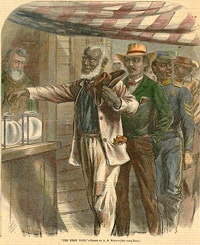History, Department of

Digital Legal Research Lab
Date of this Version
2022
Document Type
Presentation
Citation
Ellyzabeth Morales-Ledesma, "In the Waiting: The Role of the Slave Bastille in Antebellum D.C." [Research Poster]
Digital Legal Research Lab REU Site, University of Nebraska-Lincoln, 2022
Abstract
In 1808 the Transatlantic Slave Trade ended and in turn the government created a federally protected human market. As the South's demand for human labor force increased the domestic slave trade rocketed and in turn created even more turmoil for the Black population if the United States. Slave Traders and Man-Dealers took advantage of the market and kidnapped Free Black men women and children. While waiting to be sold enslaved people would be admitted into holding cells and jails; this was the creation of slave jails and Slave Bastilles. Slave jails served as places where the horrors of a human market came to life and facilitated the kidnapping of free and enslaved Black people. Slave jails in the District of Columbia facilitated the trafficking of kidnapped individuals.
Advisor: Katrina Jagodinsky
Included in
African American Studies Commons, American Politics Commons, American Studies Commons, Asian American Studies Commons, Chicana/o Studies Commons, Digital Humanities Commons, Ethnic Studies Commons, Latina/o Studies Commons, Legal Studies Commons, Native American Studies Commons, Political History Commons, Public History Commons, United States History Commons, Women's History Commons


Comments
Copyright 2024, Ellyzabeth Morales-Ledesma. Used by permission